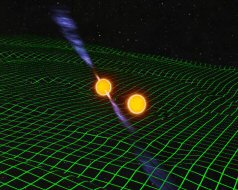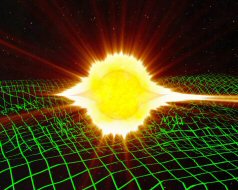Pulsar find boosts hope for gravity-wave hunters
3rd December 2003

Pulsar J0737-3039 and its neutron-star companion.
The system is emitting gravity waves, shown here as ripples in a spacetime grid. Credit: John Rowe Animation.
Click here for images and animations
Neutron star pairs may merge and give off a burst of gravity waves about six times more often than previously thought, scientists report in today's issue of the journal Nature [ 4th December 2003]. If so, the current generation of gravity-wave detectors might be able to register such an event every year or two, rather than about once a decade - the most optimistic prediction until now. This means that the the direct detection of gravity waves - a key prediction made by Albert Einstein's general theory of relativity - might be closer than previously suspected. Astronomers have indirect evidence of their existence but have yet to detect them directly.
Until now, it was thought that such neutron star mergers were comparatively rare, about one every few decades, but the discovery of the new binary system by an international team of scientists from Italy, Australia, the UK and the USA using the 64-m Parkes radio telescope in New South Wales has enabled the estimate of such an occurrences to be greatly increased.
As team member Dr Dick Manchester of CSIRO pointed out, "It is now thought that they might occur at least six or seven times more often." Professor Andrew Lyne, Director of the University of Manchester's Jodrell Bank Observatory, added, "this discovery is good news for gravity-wave astronomers; it may be possible to study one of these cosmic catastrophes every few years, instead of having to wait half a career."
Both objects in orbit around each other are "neutron" stars, city-sized balls of a super-dense form of matter - the remnants of supernovae, the cataclysmic explosions that mark the death of giant stars. One of the neutron stars is a pulsar, PSR J0730-3039. It is spinning round 45 times per second emitting rotating beams of radio waves which were detected as regular pulses of energy at the Parkes Telescope. Detailed timing analysis of these pulses allowed the extreme characteristics of the neutron star's orbit to be determined.

The pulsar and its companion merging. The merged object may become a black hole. Credit: John Rowe Animation. Click here for images and animations
Though separated by more than twice the distance of the Moon from the Earth, their large masses, each somewhat more than our Sun, mean that they orbit each other in just over 2 hours. As a result, they are already losing energy by radiating gravitational waves - but currently at too low a level to be detected directly. This is causing a "dance of death" during which the two stars slowly spiral in towards each other. They will finally fuse - perhaps forming a black hole - in about 85 million years resulting in a burst of gravity wave rippling out across the galaxy at the speed of light. As Professor Nicolo D'Amico, Director of the Cagliari Astronomical Observatory in Sardinia, stated, "if this were to happen now, it could be detected by the current generation of gravitational wave detectors such as LIGO-I, VIRGO or GEO."
The importance of this discovery is that it implies that these events are likely to occur much more frequently than thought before. "We now expect that the current gravitational wave detectors could register a neutron star merger every one or two years" said Dr Vicky Kalogera, Assistant Professor of Physics and Astronomy at Northwestern University in Illinois, USA, who with colleagues Chunglee Kim and Duncan Lorimer have modelled the coalescence rates to provide the new estimates. "It does look now as though it may not be too long before we will have the exciting prospect of the first direct detection of gravitational waves."
This new system is more extreme than any previously discovered and, because it contains a pulsar, it forms a superb test-bed for testing Einstein's predictions. Pulsars are incredibly accurate clocks and this property will enable us to understand gravity under extreme conditions. Gravity is one of the fundamental forces of the Universe and determines the evolution and structure of the Universe as we see it today.
Publication
M. Burgay, N. D'Amico, A. Possenti, R.N. Manchester, A.G. Lyne, B.C. Joshi, M.A. McLaughlin, M. Kramer, J.M. Sarkissian, F. Camilo, V. Kalogera, C.Kim & D.R. Lorimer. "An increased estimate of the merger rate of double neutron stars from observations of a highly relativistic system". Nature 426, 531-533 (2003).
Contacts
Professor Andrew Lyne,
University of Manchester,
Jodrell Bank Observatory,
+44-(0)-1477-572640
agl@jb.man.ac.uk
Dr. Michael Kramer
University of Manchester,
Jodrell Bank Observatory,
+44-(0)-1477-572622
mkramer@jb.man.ac.uk
Background information
The Parkes survey using a multi-beam system that lead to the discovery of the reported system is an international collaboration of a team of astronomers from the UK, Australia, Italy and the USA. The researchers have been surveying our Galaxy, the Milky Way, for new radio pulsars using the 64-metre Parkes Radio Telescope in New South Wales, Australia. The powerful new "multibeam" receiver was built as a joint venture between engineers at the Australia Telescope National Facility and the University of Manchester's Jodrell Bank Observatory, funded by the Particle Physics and Astronomy Research Council.
The receiver gives the telescope 13 beams capable of scanning the sky simultaneously and, as Professor Andrew Lyne of the University of Manchester, explained, "It's like having over a dozen giant radio telescopes operating at once". As a result, the system requires 13 sets of sophisticated data acquisition systems, one for each beam, which were largely developed and built by the UK group. Following initial detection at Parkes, confirmation and follow-up observations for many of the new pulsars are being made with the 76-metre Lovell Radio Telescope at Jodrell Bank.
Thanks to this new, state-of-the-art system, the survey is discovering new pulsars at a rate more than 10 times greater than any previous search has achieved - about one for every hour of observing time. It has already added over 700 new pulsars to the nearly 800 known when the survey began about five years ago.
A pulsar is the collapsed core of a massive star that has ended its life in a supernova explosion. Weighing more than our Sun, yet only 20 kilometres across, these incredibly dense objects produce beams of radio waves which sweep round the sky like a lighthouse, often hundreds of times a second. Radio telescopes receive a regular train of pulses as the beam repeatedly crosses the Earth so the objects are observed as a pulsating radio signal.
Pulsars make exceptional clocks, which enable a number of unique astronomical experiments. Some very old pulsars, which have been "spun up" to speeds of over 600 rotations per second by material flowing onto them from a companion star, appear to be rotating so smoothly that they may be even "keep time" more accurately than the best atomic clocks here on Earth. Very precise timing observations of systems in which a pulsar is in orbit around another neutron star have been able to prove the existence of gravitational radiation as predicted by Albert Einstein and have provided very sensitive tests of his theory of General Relativity - the theory of gravitation which supplanted that of Isaac Newton. The neutron star binary system reported in this paper is one of these systems, with an orbit which is decaying more rapidly than any previously discovered.
Images and Animations
- Pulsar J0737-3039 and its neutron-star companion
The system is emitting gravity waves, shown here as ripples in a spacetime grid.
Credit: John Rowe Animation
JPEG IMAGE (109K)
TIFF IMAGES - BROADCAST RESOLUTION (400K and up)
MPEG2 ANIMATION FOR WEB (320x256, 3MB)
PAL MPEG2 ANIMATION FOR BROADCAST (20MB)
- The pulsar and its companion merging
The merged object may become a black hole.
Credit: John Rowe Animation
JPEG IMAGE (88K)
TIFF IMAGES FROM ANIMATION - BROADCAST RESOLUTION (400K and up)
MPEG2 ANIMATION FOR WEB (320 x 256, 5MB)
PAL MPEG2 ANIMATION FOR BROADCAST (29MB)
- The pulsar and its companion orbiting before merging
Credit: Michael Kramer, JBO.
AVI format 6MB
MPG format 5MB
- The CSIRO Parkes radio telescope
JPEG IMAGE (66K)
Photo: CSIRO


